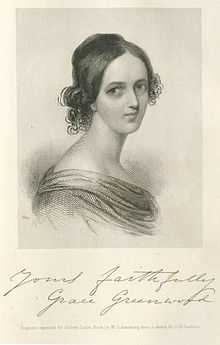Sara Jane Lippincott
| Sara Jane Lippincott | |
|---|---|
 Frontispiece of Grace Greenwood, in Godey's Lady's Book, 1848 | |
| Born |
September 23, 1823 Pompey, New York |
| Died |
April 20, 1904 (aged 81) New Rochelle New York |
| Pen name | Grace Greenwood |
| Occupation | journalist, novelist, poet |
| Nationality | American |
| Genre | journalism, fiction, poetry, children's literature |
| Subject | women's rights, abolition |
| Spouse | Leander K. Lippincott |
| Children | Annie Grace |

Sara Jane Lippincott (1823–1904) was better known by the pseudonym Grace Greenwood. She was an American author, poet, and lecturer. One of the first women to gain access into the Congressional press galleries, she used her questions to advocate for social reform and women's rights.
Biography

Sara Jane Clarke was born on September 23, 1823 at Pompey, New York to parents Deborah Baker Clarke (c. 1791–1881) and Dr. Thaddeus C. Clarke (1770–1854).[1] Her family moved to New Brighton, Pennsylvania, where her father practiced as a physician. There she attended the Greenwood Institute, a ladies' academy, from which she may have taken her pseudonym. On October 17, 1853 she married Leander K. Lippincott, and they had a daughter, Annie Grace, born October 3, 1855. Her husband left the country in 1876 after indictment for land fraud. Later she lived with her daughter in New Rochelle, New York, where she died of bronchitis[2] on April 20, 1904. Grace Greenwood is buried in the Civil War section of Grove Cemetery in New Brighton.[3]
Career
Grace Greenwood's earliest writing was poetry and children's stories, which she published in local papers. In 1844, she drew national attention, at age 21, with a poem published in the New York Mirror. She wrote under both her given name and her pseudonym. In the February 14, 1846 issue of the Home Journal, The Wife's Appeal, a poem by Miss Sara J. Clarke, is published just above Tit-for-Tat, a story by Grace Greenwood. Her work was published frequently in the widely read magazines of the day. Her poetry received significant critical attention. She became a prominent member of the literary society of New York along with Anne Lynch Botta, Edgar Allan Poe, Margaret Fuller, Ralph Waldo Emerson and Horace Greeley, Richard Henry Stoddard, Andrew Carnegie, Mary Mapes Dodge, Julia Ward Howe, Charles Butler, Fitz-Greene Halleck, Delia Bacon, and Bayard Taylor, among others. By October 1849, Godey's Lady's Book listed her as an assistant editor and she was also editor of Godey's Dollar Newspaper. Her published collection Poems (1851) included passionate poetry and references to her intimate friendship to Anna Phillips, indicating an acceptance of intimate same sex friendships.[3]
She became a highly respected journalist and consistently argued for the reform of women's roles and rights. In 1852, she went to Europe on an assignment for the New York Times. Greenwood was the first woman reporter on the Times payroll.[4] She joined the National Era, a weekly abolitionist newspaper, and copy edited the serialized original version of Harriet Beecher Stowe's Uncle Tom's Cabin as well as writing columns, travel letters, and articles. Her staunch abolitionist views contributed to the ongoing national controversy. Nathaniel Hawthorne criticized her travel letters, calling her an "ink-stained woman" and claiming he could do as well. Despite this, Greenwood seems to have gotten along amiably with Hawthorne's family. She dedicated her children's book Recollections of My Childhood, and Other Stories to Julian and Una Hawthorne. She also became a correspondent for the Saturday Evening Post.

In 1853, Greenwood and her husband started The Little Pilgrim,[5] an American children's magazine. She was soon producing magazine articles and essays. After her husband fled the United States in 1876 to escape prosecution for misappropriation of government funds, Greenwood continued her writing and resumed lecturing in order to support herself and her daughter.[3]
Greenwood lectured extensively before and during the Civil War, giving particular attention to her abolitionist stance and to other social issues, such as prison and asylum reform, and the abolition of capital punishment. President Abraham Lincoln referred to her as "Grace Greenwood the Patriot".[2] However, women's rights became the focus of her speeches, particularly after the war. Her writings from this period were republished in Records of Five Years (1867). By the 1870s, Greenwood wrote primarily for the New York Times. Her articles focused mainly on women's issues, such as advocating for Fanny Kemble's right to wear trousers, Susan B. Anthony's right to vote and all women's right to receive equal pay for equal work.
Greenwood and her daughter moved to Europe around 1882. She worked for the London Journal, and also wrote a biography, Queen Victoria: Her Girlhood and Womanhood (1883). In 1887 she returned to the United States and continued to work until 1900. Her obituary was on the front page of the New York Times, "proving her importance as a literary figure in the nineteenth century".[3]
Works
- Greenwood Leaves (1850)
- History of my Pets (1851)
- Poems (1851)
- Recollections of my Childhood, and other stories (1852)
- Haps and Mishaps of a Tour in Europe (1854)
- Merrie England (1855)
- Forest Tragedy, and other tales (1856)
- Stories and Legends of Travel and History (1857)
- Stories from Famous Ballads (1860)
- Bonnie Scotland (1861)
- Records of Five Years (1867)
- Stories and Sights of France and Italy (1867)
- Stories of Many Lands (1867)
- Summer Etchings in Colorado (1873)
- New Life in New Lands (1873)
- Heads and Tails: studies and stories of pets (1875)
- Emma Abbott, prima donna (1878)
- Queen Victoria, her girlhood and womanhood (1883)
- Stories for Home-folks, young and old (1884)
- Stories and Sketches (1892) (with Rossiter W. Raymond)
- Treasures from Fairyland (1879)
References
- ↑ "Beaver County History Online". Sara Jane Clarke (Grace Greenwood). Retrieved January 31, 2008.
- ↑ 2.0 2.1 "Portraits of American Women Writers". GRACE GREENWOOD (1823-1904). Retrieved January 31, 2008.
- ↑ 3.0 3.1 3.2 3.3 "English Literature: Nineteenth Century: Authors: Greenwood, Grace (1823-1904)". Literature Online. Retrieved January 31, 2008.(requires interlibrary account access)
- ↑ "New York State Newspapers". The New York Times : A Chronology: 1851-2006. Retrieved February 2, 2008.
- ↑ "American children's periodicals, 1789-1872". The Little Pilgrim ; Oct 1853-Dec 1868. Retrieved February 1, 2008.
External links
| Wikimedia Commons has media related to Sara Jane Lippincott. |
- Works by Grace Greenwood at Project Gutenberg
- Works by or about Grace Greenwood at Internet Archive
- Works by Grace Greenwood at LibriVox (public domain audiobooks)

|